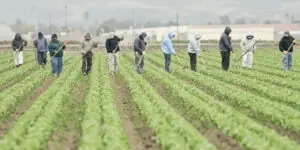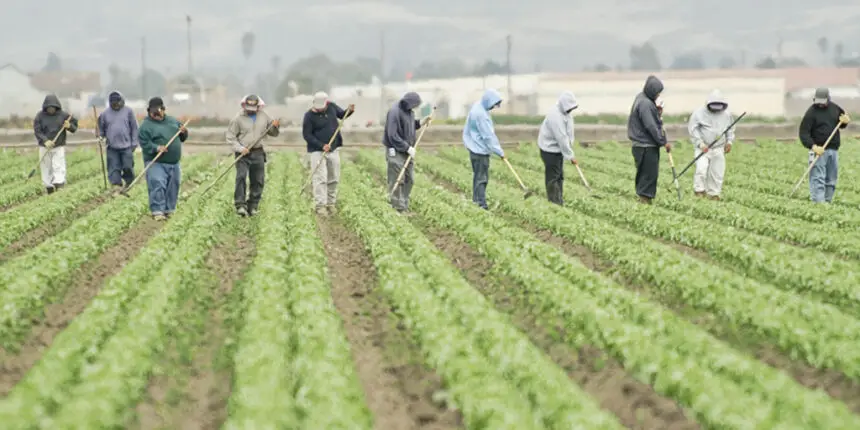Confronted with soaring food prices and pressure from a strained agricultural sector, the Trump administration has quietly shifted its immigration strategy. It is making it easier for farmers to hire foreign labor and appears to be reducing the frequency of ICE raids on farms. This shift stands in stark contrast to the administration’s public pledge to build a “100% American workforce.”
A Growing Reliance on H-2A Farmworkers
According to a Stateline report, the White House made major changes last month to the H-2A agricultural visa program. Farmers use this program to recruit seasonal foreign labor. The Department of Homeland Security can now approve visas faster to address persistent labor shortages.
The U.S. Department of Agriculture confirmed the policy shift and told Stateline that the administration is prioritizing fixing the programs farmers and ranchers rely on. Yet as recently as July, Agriculture Secretary Brooke Rollins reaffirmed the administration’s goal of relying solely on American labor.
Since 2023, the H-2A program has issued about 420,000 visas each year. These cover nearly half of all agricultural jobs in the country. Under the new rules, the government expects to issue an additional 119,000 visas.
The changes also lower minimum wages for H-2A workers in many states. Employers can now charge for housing, which was previously free.
In North Carolina, for example, the hourly wage for non-skilled workers dropped from $16.16 to $11.09.
Growers Applaud, Labor Unions Push Back
Grower associations have welcomed the adjustments.
“If you think farmers are making more money in these conditions, you’re wrong. They’re going broke,” said Lee Wicker of the North Carolina Growers Association. He believes most workers will return despite wage cuts.
“If you think farmers are making more money in these conditions, you’re wrong. They’re going broke,” said Lee Wicker of the North Carolina Growers Association. He believes most workers will return despite wage cuts.
Economist Jeffrey Dorfman of North Carolina State University said the policy “will save farmers tens of millions of dollars statewide.”
Labor unions, however, sound the alarm.
“First came the raids, which terrorized workers. Now, to appease business interests, they’re making massive concessions on wages and the guestworker program,” said Antonio De Loera-Brust of the United Farm Workers.
“First came the raids, which terrorized workers. Now, to appease business interests, they’re making massive concessions on wages and the guestworker program,” said Antonio De Loera-Brust of the United Farm Workers.
Fewer Raids in the Fields — But Not Elsewhere
At the same time, experts note a significant decline in ICE operations on farms since late summer.
After several high-profile agricultural workplace raids earlier in the year, the agency now appears focused on other sectors.
“We really haven’t seen agriculture targeted with worksite enforcement,” said Julia Gelatt of the Migration Policy Institute. She noted that previous administrations had also quietly deprioritized farm raids without formal announcements.
“We really haven’t seen agriculture targeted with worksite enforcement,” said Julia Gelatt of the Migration Policy Institute. She noted that previous administrations had also quietly deprioritized farm raids without formal announcements.
In North Carolina, Wicker confirms that farms have not been targeted, even as ICE activity increases in urban centers.
Still, De Loera-Brust warns: “Raids in the fields have slowed, but they could resume at any time,” leaving workers in ongoing uncertainty.
Still, De Loera-Brust warns: “Raids in the fields have slowed, but they could resume at any time,” leaving workers in ongoing uncertainty.
A Strategy Tied to Food-Price Pressures
Beyond immigration policy, the moves fit into a broader economic strategy. The food industry is struggling with rising global production costs, crop diseases, and volatile weather patterns.
This week, the trade outlet FreshPlaza reported that the Trump administration lifted certain import tariffs on goods such as bananas, coffee, and beef. Reactions are mixed: some say retailers may not pass savings on to consumers, while others welcome relief for a supply chain already under severe strain.
“Eliminating some of these tariffs provides much-needed stability and predictability,” said Daniella Velazquez De Leon of Organics Unlimited, cautioning that weather, disease, and tight global supplies will continue to shape prices.
Agricultural Policy Caught Between Contradiction and Pragmatism
The latest developments point to a contradiction. President Trump’s political rhetoric emphasizes hardline immigration controls and “America First.” Yet his administration is implicitly acknowledging that U.S. agriculture depends on foreign labor. The sector is too fragile to withstand a sudden reduction in its workforce.
The expansion of the H-2A program, wage cuts, and the decline in farm raids all signal a more pragmatic turn. These moves are shaped by economic pressure and labor-market realities.
Whether this strategy will satisfy growers, reassure workers, or quell union criticism remains uncertain. For now, American agriculture continues to navigate a precarious balance between immigration policy, economic necessity, and the everyday realities of farm labor.








